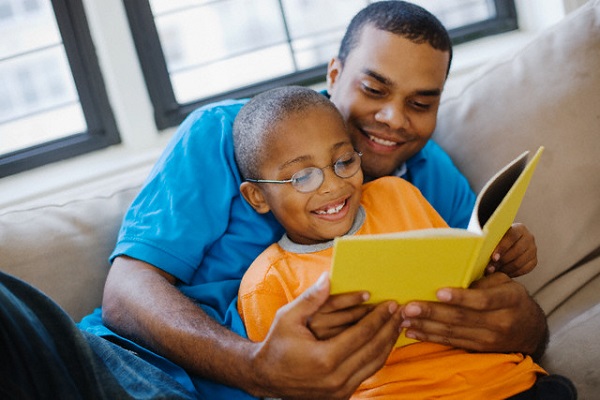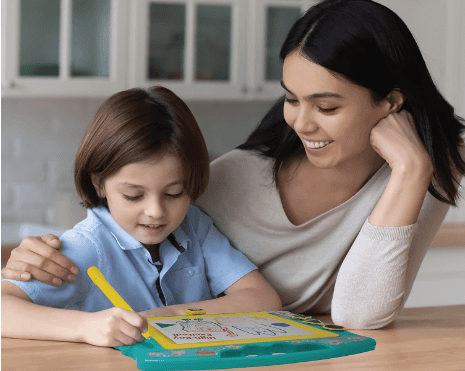10 Fun Phonics Activities to Teach Letter Sounds

|
Getting your Trinity Audio player ready...
|
Understanding Phonics: The Connection of Letters and Sounds
Phonics is the relationship between letters and sounds as well as the understanding of how those sounds connect to form words.
For instance, the /c/ sound, the short /a/ sound, and the /t/ sound blend together to form the word cat.
Research Highlights the Importance of Phonics Instruction and Multi-Sensory Techniques

Here is a sample activity for you to try: Take three to four-letter words and mix up their letters. For instance, if the word is “pig,” arrange the letters (e.g., “ipg”) on the table in front of your child. Make sure to place the letters about one to two feet away from your child, allowing them enough space to work. Then, provide them with a sheet of paper that has three (or four) blank spaces for letters, like this: _ _ _.Afterward, either tell them the word or show them a picture of the word, and give them the following instruction: “Switch around the letters above to create the word ‘pig’ on the lines below.”

If you have Magnetic Letters, they can be utilized for the same purpose. Additionally, you can motivate your child to write the letters using a pen or pencil. Introducing word families can help your child understand that numerous words share the same spelling, differing only in their initial letter.For instance, after “pig,” they can try “big,” “wig,” and “rig.” Incorporating rhyming practice is another beneficial technique when teaching children about letter sounds.

Create a grid either by drawing it on paper or using a computer program. An example of a grid is provided below. (Alternatively, you can obtain a larger version of the grid by printing it here. Additional blank Bingo grids can be found here.)

The grid above has 25 boxes but can also be played as phonics Bingo with either 9 or 16 boxes.
1. Draw simple pictures in each box, such as an apple, a banana, a comb, a door, an egg, a feather, a girl, a hat, an ice-cube, a jar, a kite, a light bulb, a mitten, a nose, an orange, a pan, a queen, a ring, a spoon, a table, an umbrella, a vase, a worm, a xylophone (this may be challenging to draw), and a zipper. Use colors to make it more enjoyable.
2. Find images on Google Images, print them, cut them out, and glue them in the boxes.
3. Copy images from Google Images by either hitting “control c” or right-clicking on the image and selecting copy. Then, paste each picture into the grid box by right-clicking in the box and clicking the word Paste or by hitting Control V on the keypad or keyboard.
4. Search for Kids Bingo Grids and print out ready-made Bingo grids.
There are four ways to play the Bingo game.
3. Call out a letter sound. If your child has a picture that ends with that letter sound, they should cover the picture.
4. Call out a letter. If your child has a picture that ends with that letter, they should cover the picture.
When your child fills up a row, either vertically, horizontally, or diagonally, they get Bingo and win the game.
5. Create flashcards with a picture on one side and the corresponding beginning or ending letter/sound on the other side.

You have the option to create your own drawings or use images from Google Images to make flashcards.
To make a flashcard using Google Images, visit the website and select an image. Copy the image by right-clicking on it and choosing “copy” or by using the shortcut “control c.” Then, open a word document and paste the image by right-clicking and selecting “paste” or using the shortcut “control v.” After that, print out the pages, cut out the pictures, and write the corresponding letter on the back.
If you are familiar with inserting tables, you can arrange multiple pictures on a page using table boxes. Then you can print the page, cut out the pictures, and label the letters on the back.
Here is an example of how to use the flashcards: Show a picture to your child and ask them to identify the letter (or letter sound) that it starts with (or ends with). If they answer correctly, acknowledge their response and show them the back of the card. If their answer is incorrect, give them two more attempts. If they still can’t identify the letter or sound, show them the back of the card and inform them of the correct letter and sound. Ask them to repeat the letter/sound twice and then shuffle the card back into the deck. Repeat this process.
To make it more exciting do a silly dance, tell a joke, or toss a ball in between each flash card presented.
To create a flashcard using Google Images, go to the website and choose an image. Copy the image by right-clicking and selecting “copy” or using the shortcut “control c.” Then, open a Word document (or similar program) and paste the image by right-clicking and choosing “paste” or using the shortcut “control v.”
Print out the pages, cut out the pictures, and write the corresponding letter on the back.
Alternatively, if you know how to insert tables, you can use table boxes to arrange multiple pictures on a page. Print the page, cut out the pictures, and label the letters on the back.
Here is an example of how to use the flashcards: Display a picture to your child and ask them to identify the letter or letter sound it begins or ends with. If they answer correctly, acknowledge their response and show them the back of the card. If they answer incorrectly, give them two more attempts.
If they are still unsure of the letter or sound, show them the back of the card and tell them the correct letter and sound. Ask them to repeat the letter or sound twice and then shuffle the card back into the deck. Repeat this process.
To make it more enjoyable, you can add a silly dance, tell a joke, or play catch between each flashcard.
Tape four letters onto the wall as shown in the image above:
Call out a letter sound and tell your child to run to the letter that makes that sound, touch it and run back. Spice it up. Here are some examples:
-Hop to the letter that makes the sound
-Skip to the letter that makes the sound
-Tip Toe to the letter that makes the sound
7. Play “Run to the Letter Sound!”
Incorporate some excitement into your phonics lesson by taping four letters onto the wall, just like the image below.

Engage your child by calling out a letter sound and directing them to run to the letter that corresponds to that sound. They should touch it and then run back. To make it more interesting, you can try different variations such as hopping to the letter that makes the sound, skipping to the letter that makes the sound, or even tip-toeing to the letter that makes the sound.
Another fun movement activity involves placing tape on the floor, with a different letter on each piece of tape.
Begin by telling your child to position their feet on a specific letter, for example, start on letter A.
Then, ask them to jump to various letters while using the corresponding letter sounds. For instance, you can say, “Jump to the letter that makes the sound (insert letter sound).”
Take a look at the example below of letters taped to the floor, for further clarification.

As your child’s letter sound skills improve, you can engage them in spelling real words using the letters.For instance, if you want to spell the word “cat,” you can use three pieces of tape with the letters C, A, and T written on them. Instruct your child to begin at the C, then jump to the next letter in the word (A), and finally, to the last letter (T). To make it more challenging, encourage your child to spell the word in reverse by starting with the last letter and progressing in order until they reach the first letter.While the example above uses three letters, feel free to use as many pieces of tape and letters as desired. Initially, start with a few letters and gradually increase the difficulty level as your child demonstrates progress.

Click here to print out your own version of this sheet.
For children who may have trouble solving this worksheet, try providing them with a letter bank to see if that helps.
See an example of a worksheet with a letter bank below.

Click here to print out your own version of a phonics worksheet with a letter bank.
Supervise the activity, providing assistance as needed.
When your child is done, you can hang up their work to show them that you are proud of their effort.
You can also use this idea to teach a child how to spell their name, such as the sample in the image below.You can specify the exact number of letters needed for the word or add extra letters, to make the activity more challenging.Start by stating the initial sound of the word and have your child choose the correct letter and place it in the right position. Repeat this process for each subsequent sound until the word is fully spelled.Make sure to supervise the activity and offer help when necessary.Once your child completes the word, you can display their work to demonstrate your pride in their effort.A similar approach can also be used to teach a child how to spell their own name, as illustrated in the example shown in the accompanying image.

The tune is similar to the traditional alphabet song.
See a great example by Kidstv123 in the video below. You can make up your own version as well.
When to Seek Help: Addressing Learning Needs in Children
If your child is facing significant difficulties in learning letter sounds or acquiring other academic skills, even after consistent practice and guidance, it is advisable to reach out to your child’s school and/or doctor. They will be able to direct you to the appropriate professionals who can assess the potential obstacles impeding your child’s progress and explore additional strategies that may be beneficial.
- 3 Ways to Use Timers to Encourage Homework and Chore Completion
- How to Use Schedules to Improve Behavior







